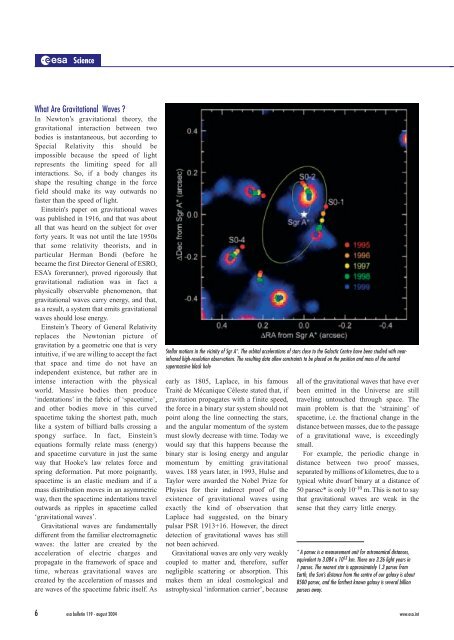Gravitational Waves and Massive Black Holes? – The LISA
Gravitational Waves and Massive Black Holes? – The LISA
Gravitational Waves and Massive Black Holes? – The LISA
Create successful ePaper yourself
Turn your PDF publications into a flip-book with our unique Google optimized e-Paper software.
Science<br />
What Are <strong>Gravitational</strong> <strong>Waves</strong> ?<br />
In Newton’s gravitational theory, the<br />
gravitational interaction between two<br />
bodies is instantaneous, but according to<br />
Special Relativity this should be<br />
impossible because the speed of light<br />
represents the limiting speed for all<br />
interactions. So, if a body changes its<br />
shape the resulting change in the force<br />
field should make its way outwards no<br />
faster than the speed of light.<br />
Einstein's paper on gravitational waves<br />
was published in 1916, <strong>and</strong> that was about<br />
all that was heard on the subject for over<br />
forty years. It was not until the late 1950s<br />
that some relativity theorists, <strong>and</strong> in<br />
particular Herman Bondi (before he<br />
became the first Director General of ESRO,<br />
ESA’s forerunner), proved rigorously that<br />
gravitational radiation was in fact a<br />
physically observable phenomenon, that<br />
gravitational waves carry energy, <strong>and</strong> that,<br />
as a result, a system that emits gravitational<br />
waves should lose energy.<br />
Einstein’s <strong>The</strong>ory of General Relativity<br />
replaces the Newtonian picture of<br />
gravitation by a geometric one that is very<br />
intuitive, if we are willing to accept the fact<br />
that space <strong>and</strong> time do not have an<br />
independent existence, but rather are in<br />
intense interaction with the physical<br />
world. <strong>Massive</strong> bodies then produce<br />
‘indentations’ in the fabric of ‘spacetime’,<br />
<strong>and</strong> other bodies move in this curved<br />
spacetime taking the shortest path, much<br />
like a system of billiard balls crossing a<br />
spongy surface. In fact, Einstein’s<br />
equations formally relate mass (energy)<br />
<strong>and</strong> spacetime curvature in just the same<br />
way that Hooke's law relates force <strong>and</strong><br />
spring deformation. Put more poignantly,<br />
spacetime is an elastic medium <strong>and</strong> if a<br />
mass distribution moves in an asymmetric<br />
way, then the spacetime indentations travel<br />
outwards as ripples in spacetime called<br />
‘gravitational waves’.<br />
<strong>Gravitational</strong> waves are fundamentally<br />
different from the familiar electromagnetic<br />
waves: the latter are created by the<br />
acceleration of electric charges <strong>and</strong><br />
propagate in the framework of space <strong>and</strong><br />
time, whereas gravitational waves are<br />
created by the acceleration of masses <strong>and</strong><br />
are waves of the spacetime fabric itself. As<br />
Stellar motions in the vicinity of Sgr A*. <strong>The</strong> orbital accelerations of stars close to the Galactic Centre have been studied with nearinfrared<br />
high-resolution observations. <strong>The</strong> resulting data allow constraints to be placed on the position <strong>and</strong> mass of the central<br />
supermassive black hole<br />
early as 1805, Laplace, in his famous<br />
Traité de Mécanique Céleste stated that, if<br />
gravitation propagates with a finite speed,<br />
the force in a binary star system should not<br />
point along the line connecting the stars,<br />
<strong>and</strong> the angular momentum of the system<br />
must slowly decrease with time. Today we<br />
would say that this happens because the<br />
binary star is losing energy <strong>and</strong> angular<br />
momentum by emitting gravitational<br />
waves. 188 years later, in 1993, Hulse <strong>and</strong><br />
Taylor were awarded the Nobel Prize for<br />
Physics for their indirect proof of the<br />
existence of gravitational waves using<br />
exactly the kind of observation that<br />
Laplace had suggested, on the binary<br />
pulsar PSR 1913+16. However, the direct<br />
detection of gravitational waves has still<br />
not been achieved.<br />
<strong>Gravitational</strong> waves are only very weakly<br />
coupled to matter <strong>and</strong>, therefore, suffer<br />
negligible scattering or absorption. This<br />
makes them an ideal cosmological <strong>and</strong><br />
astrophysical ‘information carrier’, because<br />
all of the gravitational waves that have ever<br />
been emitted in the Universe are still<br />
traveling untouched through space. <strong>The</strong><br />
main problem is that the ‘straining’ of<br />
spacetime, i.e. the fractional change in the<br />
distance between masses, due to the passage<br />
of a gravitational wave, is exceedingly<br />
small.F<br />
For example, the periodic change in<br />
distance between two proof masses,<br />
separated by millions of kilometres, due to a<br />
typical white dwarf binary at a distance of<br />
50 parsec* is only 10 -10 m. This is not to say<br />
that gravitational waves are weak in the<br />
sense that they carry little energy. mean<br />
that gravitational waves are weak in the<br />
sense that they carry little energy. On the<br />
contrary, a supernova in a not too distant<br />
* A parsec is a measurement unit for astronomical distances,<br />
equivalent to 3.084 x 10 13 km. <strong>The</strong>re are 3.26 light years in<br />
1 parsec. <strong>The</strong> nearest star is approximately 1.3 parsec from<br />
Earth, the Sun’s distance from the centre of our galaxy is about<br />
8500 parsec, <strong>and</strong> the farthest known galaxy is several billion<br />
parsecs away.<br />
6 esa bulletin 119 - august 2004 www.esa.int

















